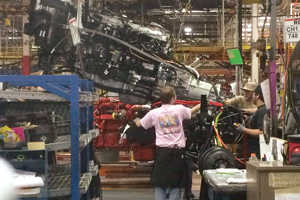Some Question Resale Value, Durability of Smaller Engines

This story appears in the April 11 print edition of Equipment & Maintenance Update, a supplement to Transport Topics.
Not everyone thinks 11- and 12-liter engines are right for their fleets and operations.
Baltimore-based fleet Cowan Systems, which has about 1,400 tractors, runs about 60% International models and the rest Peterbilts, all with 13-liter engines.
“The 11-liter has been entertained in some markets, but I think our biggest fear is resale,” said Michael Sizemore, Cowan’s director of maintenance. “That’s the biggest factor to not entertain the change. Also, sometimes we’ve got to climb mountains, and other times, we are in the valley.
BEST OF APRIL E&MU: More stories, columns
“We haven’t tested this product to see how it would perform in a different environment, but we have the preconceived notion that it won’t perform as efficiently. Now the only way to really find that out is to obviously try it.”
Sizemore is not alone in his concern about resale value. A report released last year by the North American Council for Freight Efficiency concluded that “until residual buyers and drivers are convinced that the smaller engines are sufficient for their application, the transition to these lighter and lower-cost engines will be slow.”
Potential buyers also have questions about durability.
“Smaller engines are just as durable as their larger counterparts when placed in the correct conditions,” said John Moore, powertrain product marketing manager for Volvo Trucks, which offers a 10.8-liter D11 engine. “You would not spec a D11 to run a loaded linehaul operation at 75 mph through the Rocky Mountains, nor would you use it to haul 65 tons in British Columbia. When used for the proper conditions, smaller displacement engines last just as long.”
Moore and others interviewed pointed to one measure of engine durability for customers, known as “B life.” For instance, an engine rated as B-10 refers to the expected engine life, measured in miles of operations, before 10% of all engines in operation will require a major repair, overhaul or replacement.
“I think that is important to understand with these engines: You are able to get something lower priced, a lower weight and not sacrifice durability,” said Mike Evans, senior consultant at Rhein Associates.
Just because 11- to 12-liter engines are an answer for many fleets, the bigger 13-liter and 15-liter engines are hardly on the way out, said Mario Sanchez-Lara, director of on-highway marketing communications for Cummins Inc., which makes the 11.9-liter ISX12 model engine.
“The power needs of vocational and heavy-haul fleets remain, and we continue to see demand for engines with displacement above 13 liters. So the heavy-duty truck market is not converging in on a power node that can be optimally covered by a single displacement or engine size,” he said.
However, he pointed out that the global nature of the truck and engine business is driving development of the smaller power units.
“The quest for lower cost drives for larger scale, which has motivated OEMs to leverage product adoption across more markets, especially when significant investments were made in the development of the so-called global platforms,” he said. “However, the specific needs of diverse markets and the lack of harmonized emissions standards is a challenge.”
NACFE Executive Director Mike Roeth said that, as good as these smaller engines are, because they are not as widely used as 13- or 15-liter models, it can take a while for features to appear on them that are available on larger engines, such as fuel-saving “downspeed” integrations with automated transmissions.
“We see different features on the 15-liter engines coming to market,” he said, “which is kind of frustrating because it seems like even though the smaller engine should be better at fuel economy, it tends to lag the bigger engines because [the 15-liters] get all of these sort of features first,” he said.
One engine maker absent from the 11-liter engine trend: Detroit Diesel. While parent Daimler Trucks in Europe offers a Mercedes-Benz model just below 11 liters, it has no such offering in the United States.
Kelly Gedert, manager of powertrain marketing for Daimler Trucks North America, said, “Detroit is always observing the market and evaluating our product portfolio, but at this time, there is not a plan to offer a Detroit-branded 11-liter engine.”

